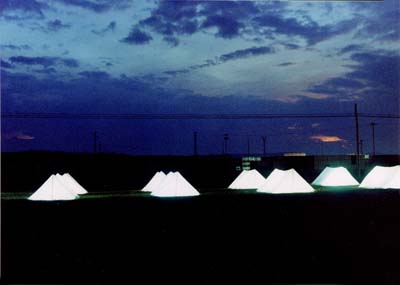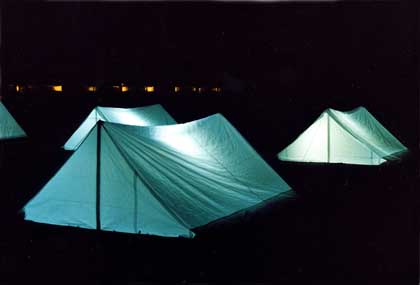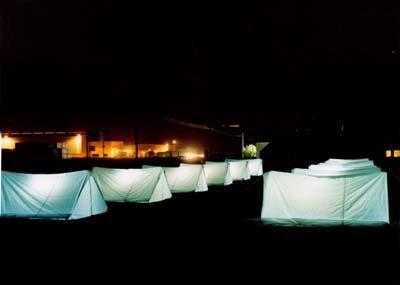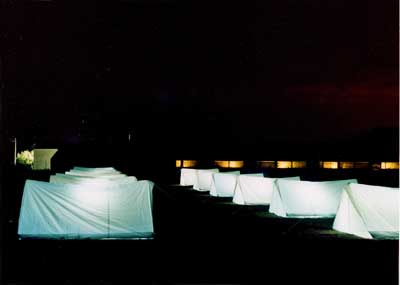|
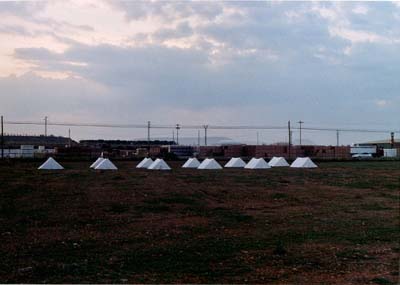
|
Settled in front of
the workshop
A journey takes on a
senseless shape in the mind. What could justify all this effort
and the 50, 60 hours of driving in a car?
That a child at 3 o'clock at night discovers artichokes as if they
were from another planet? That her mother sees a tremendous breakthrough
between two levels of terrain, or in the stenches of the chicken
farm* knocks wooden tent pegs into the soft, red, absorbent ground
with a cloth covering her face, or insulates electric cables in
the rain?
Dining Spanish with hardly any contact besides her old friend A.,
right next-door to the refurbished house in which Goya was born,
struggling with the distances, with the energy the other participants
spend by waiting, and enchanted by the spacious grapevine desert.
Each vista shifting one's consciousness, each new perspective rendering
minute the whole practical human tangle. And then the little paradise
down by the narrow Huerva River, below the tiny town, (no longer
the distorted Goya-Birthplace-Village-Inc., but Villanueva with
its wine-red-bloated winegrowers), and repeatedly, in numerous moments
during the hours of driving, views from above to the gardens along
the river, dreams cast down from the road.
The child, F., won't even allow me to have a coffee and scribble
down three aimless sentences on a piece of paper. She pulls my inner
being towards her. She modifies me with all her charm and innocence,
and I let it happen, otherwise there would be no shared happiness.
She had lots to see, people everywhere building things, wanting
things, paralleled by what her mother wanted and did, and offering
orientation for her own questions. These questions allow her to
determine the intensity with which she gets involved with constellations
of people (or whether to use her relentlessness to involve the persons
around her in what she is interested in).
|
The artists who traveled
there and were kept dependent (due to the lack of transportation)
form a group which imports its own necessities to the sites of the
grape-harvest. In Villanueva, their immobility makes them settle
down in and in front of the workshop - a group of Martians welcomed
by most.
In this respect, the child and the local residents have something
in common. Most of these Martians are occupied with things they
deem site-specific. And they are indeed right, just as they are
wrong in that one couldn't do more to make aware the differences,
the gap, between the different life-worlds than by realizing such
a project in such a place. If one lodged in a pension or at a farmer's
guest house, visited Goya's newly jointed casa natal at Placa Goya,
one might perhaps be a Chinese or someone from Madrid, but at least
a comprehensible being with the agreeable side-effect of spending
money in the area. ** One might also be a member of the Aragonian
cyclists club, privileged over cars during the weekends on the itinerary
through the region - and taking advantage of it, sweating under
a green streamlined helmet and in glossy jersey outlining the femoral
muscles. (All this seems to add to the modern functionality of rural
structures; by no means are there only old men changing their positions
on the benches according to the movement of the sun, until all have
passed away.)
translation: Benoit Maubrey,
Karl Hoffmann
* Electric current was provided by a chicken farm,
and the manure of the 40,000 animals dried close to one's nose.
(An optional site would have been a pig farm). Everything exists
smoothly side by side, animal industry and rustic jamon (ham), faces
of the 19th century and EU faces, all of them get out of the same
Opels.
** But no one has managed to push aside the thought of how completely
isolated in the universe (or on the face of the earth) Fuendetodos
was during Goya's times.
|

